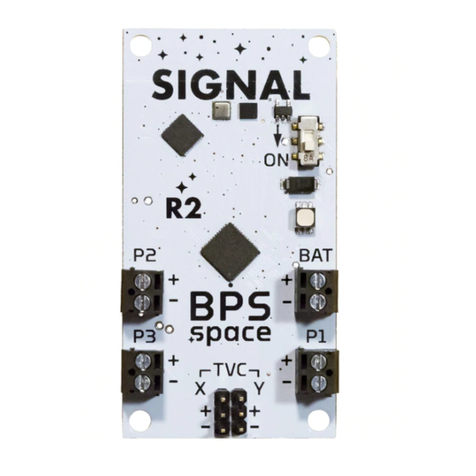4. Let’s see how the mount works! Tap and hold the TVC Test button. The mount should
swivel back and forth on each axis slowly. If either axis seems stuck, this is a good time
to check for stuck wires or tight screws.
5. Next, let’s get things lined up. Exit System Preferences, tap on “Thrust Vectoring”, then
on “Advanced”
a. Use the + and - buttons under “TVC Servo Alignment” on each axis to get the
motor mount centered. Don’t worry if it’s not perfect. Each time you hit + or -, the
computer will change where the center point of the TVC mount is
6. If you’re eager to see the whole system in action, head down to section 9b to simulate a
full flight.
7. Once that’s done, your flight hardware is ready to go in a rocket! But first, we must build
the rocket...
7. Using the drill/cut guides
Signal R2 comes with drill and cut guides for the vectoring mount and flight computer. These
guides will be wrapped around the airframe of your rocket to ensure you place the holes and
cutouts in the correct place. If you’ve already used your provided cutout guide, they can be
downloaded and printed on a regular 8.5x11 inch US letter paper, just make sure they’re printed
at 100% scaling. Head to the Build Signal R2 web page for those files.
You’ll want to start out with a brand new body tube for this to work well, though a pre painted
one can work too.
1. Wrap the TVC cutout guide around the airframe, pulling it tight. Ensure that “Line 1” can
be seen through directly beneath the three tics by the number 4. This is to simply make
sure you’re using the correct guide on the correct airframe.
a. I recommend lining up the bottom edge of the paper labeled “dirt” with the bottom
of your airframe for most ~10 cm long motors. You can move it up or down
slightly depending on the length of the motor you use. For instance, the Aerotech
G8 motor is 15 cm long, and requires about 5cm more clearance if you don’t
want it to stick out from the bottom of the rocket. It’s helpful to hold the loaded
thrust vectoring mount up next to TVC guide on the airframe to get an idea of
where things will sit once you make the cuts.
2. Carefully hold the paper against the airframe and unwrap it enough to apply tape on the
edge indicated, “Tape to vehicle here”.
3. Once again, wrap the guide around the airframe, this time taping down the other edge of
the paper, so the rocket remains covered when you let go.
4. Apply small pieces of tape on the top and bottom of the TVC guide to help secure it a bit
more.
5. Follow the same application process with the flight computer drill/cut guide. The most
important part here is to line up the small blue numbers between the two guides. 1, 2, 3,
and 4 should match up as closely as possible between the papers. You can mount the
Copyright © 2019 Barnard Propulsion Systems, LLC Version 1.8, Jan 1, 2019
www.bps.space




























